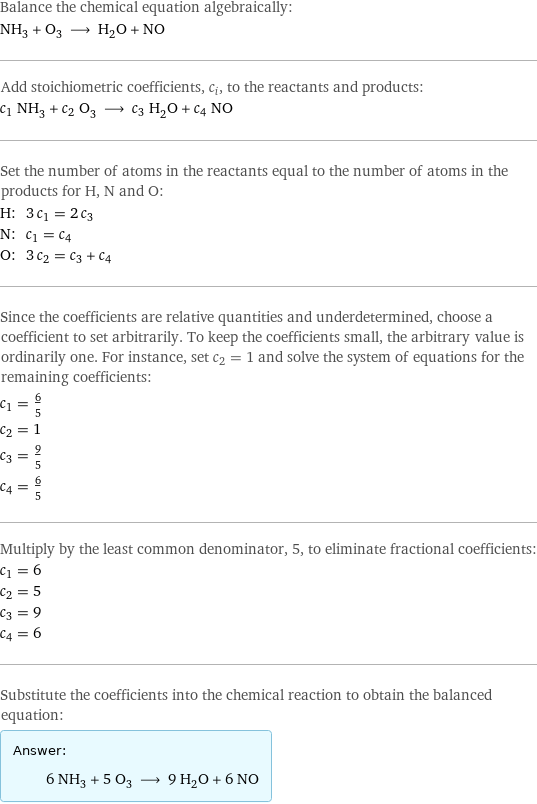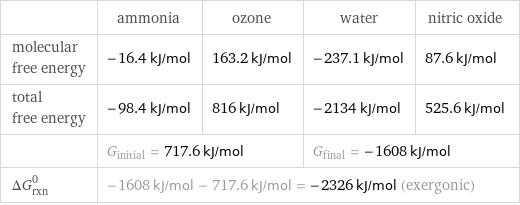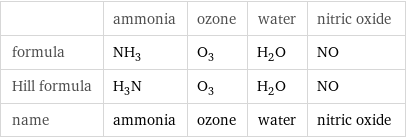Input interpretation

NH_3 ammonia + O_3 ozone ⟶ H_2O water + NO nitric oxide
Balanced equation

Balance the chemical equation algebraically: NH_3 + O_3 ⟶ H_2O + NO Add stoichiometric coefficients, c_i, to the reactants and products: c_1 NH_3 + c_2 O_3 ⟶ c_3 H_2O + c_4 NO Set the number of atoms in the reactants equal to the number of atoms in the products for H, N and O: H: | 3 c_1 = 2 c_3 N: | c_1 = c_4 O: | 3 c_2 = c_3 + c_4 Since the coefficients are relative quantities and underdetermined, choose a coefficient to set arbitrarily. To keep the coefficients small, the arbitrary value is ordinarily one. For instance, set c_2 = 1 and solve the system of equations for the remaining coefficients: c_1 = 6/5 c_2 = 1 c_3 = 9/5 c_4 = 6/5 Multiply by the least common denominator, 5, to eliminate fractional coefficients: c_1 = 6 c_2 = 5 c_3 = 9 c_4 = 6 Substitute the coefficients into the chemical reaction to obtain the balanced equation: Answer: | | 6 NH_3 + 5 O_3 ⟶ 9 H_2O + 6 NO
Structures

+ ⟶ +
Names

ammonia + ozone ⟶ water + nitric oxide
Reaction thermodynamics
Enthalpy

| ammonia | ozone | water | nitric oxide molecular enthalpy | -45.9 kJ/mol | 142.7 kJ/mol | -285.8 kJ/mol | 91.3 kJ/mol total enthalpy | -275.4 kJ/mol | 713.5 kJ/mol | -2572 kJ/mol | 547.8 kJ/mol | H_initial = 438.1 kJ/mol | | H_final = -2025 kJ/mol | ΔH_rxn^0 | -2025 kJ/mol - 438.1 kJ/mol = -2463 kJ/mol (exothermic) | | |
Gibbs free energy

| ammonia | ozone | water | nitric oxide molecular free energy | -16.4 kJ/mol | 163.2 kJ/mol | -237.1 kJ/mol | 87.6 kJ/mol total free energy | -98.4 kJ/mol | 816 kJ/mol | -2134 kJ/mol | 525.6 kJ/mol | G_initial = 717.6 kJ/mol | | G_final = -1608 kJ/mol | ΔG_rxn^0 | -1608 kJ/mol - 717.6 kJ/mol = -2326 kJ/mol (exergonic) | | |
Entropy

| ammonia | ozone | water | nitric oxide molecular entropy | 193 J/(mol K) | 239 J/(mol K) | 69.91 J/(mol K) | 211 J/(mol K) total entropy | 1158 J/(mol K) | 1195 J/(mol K) | 629.2 J/(mol K) | 1266 J/(mol K) | S_initial = 2353 J/(mol K) | | S_final = 1895 J/(mol K) | ΔS_rxn^0 | 1895 J/(mol K) - 2353 J/(mol K) = -457.8 J/(mol K) (exoentropic) | | |
Equilibrium constant
![Construct the equilibrium constant, K, expression for: NH_3 + O_3 ⟶ H_2O + NO Plan: • Balance the chemical equation. • Determine the stoichiometric numbers. • Assemble the activity expression for each chemical species. • Use the activity expressions to build the equilibrium constant expression. Write the balanced chemical equation: 6 NH_3 + 5 O_3 ⟶ 9 H_2O + 6 NO Assign stoichiometric numbers, ν_i, using the stoichiometric coefficients, c_i, from the balanced chemical equation in the following manner: ν_i = -c_i for reactants and ν_i = c_i for products: chemical species | c_i | ν_i NH_3 | 6 | -6 O_3 | 5 | -5 H_2O | 9 | 9 NO | 6 | 6 Assemble the activity expressions accounting for the state of matter and ν_i: chemical species | c_i | ν_i | activity expression NH_3 | 6 | -6 | ([NH3])^(-6) O_3 | 5 | -5 | ([O3])^(-5) H_2O | 9 | 9 | ([H2O])^9 NO | 6 | 6 | ([NO])^6 The equilibrium constant symbol in the concentration basis is: K_c Mulitply the activity expressions to arrive at the K_c expression: Answer: | | K_c = ([NH3])^(-6) ([O3])^(-5) ([H2O])^9 ([NO])^6 = (([H2O])^9 ([NO])^6)/(([NH3])^6 ([O3])^5)](../image_source/5cd0cda19e3cbc2b8af2d2d81e8eef7f.png)
Construct the equilibrium constant, K, expression for: NH_3 + O_3 ⟶ H_2O + NO Plan: • Balance the chemical equation. • Determine the stoichiometric numbers. • Assemble the activity expression for each chemical species. • Use the activity expressions to build the equilibrium constant expression. Write the balanced chemical equation: 6 NH_3 + 5 O_3 ⟶ 9 H_2O + 6 NO Assign stoichiometric numbers, ν_i, using the stoichiometric coefficients, c_i, from the balanced chemical equation in the following manner: ν_i = -c_i for reactants and ν_i = c_i for products: chemical species | c_i | ν_i NH_3 | 6 | -6 O_3 | 5 | -5 H_2O | 9 | 9 NO | 6 | 6 Assemble the activity expressions accounting for the state of matter and ν_i: chemical species | c_i | ν_i | activity expression NH_3 | 6 | -6 | ([NH3])^(-6) O_3 | 5 | -5 | ([O3])^(-5) H_2O | 9 | 9 | ([H2O])^9 NO | 6 | 6 | ([NO])^6 The equilibrium constant symbol in the concentration basis is: K_c Mulitply the activity expressions to arrive at the K_c expression: Answer: | | K_c = ([NH3])^(-6) ([O3])^(-5) ([H2O])^9 ([NO])^6 = (([H2O])^9 ([NO])^6)/(([NH3])^6 ([O3])^5)
Rate of reaction
![Construct the rate of reaction expression for: NH_3 + O_3 ⟶ H_2O + NO Plan: • Balance the chemical equation. • Determine the stoichiometric numbers. • Assemble the rate term for each chemical species. • Write the rate of reaction expression. Write the balanced chemical equation: 6 NH_3 + 5 O_3 ⟶ 9 H_2O + 6 NO Assign stoichiometric numbers, ν_i, using the stoichiometric coefficients, c_i, from the balanced chemical equation in the following manner: ν_i = -c_i for reactants and ν_i = c_i for products: chemical species | c_i | ν_i NH_3 | 6 | -6 O_3 | 5 | -5 H_2O | 9 | 9 NO | 6 | 6 The rate term for each chemical species, B_i, is 1/ν_i(Δ[B_i])/(Δt) where [B_i] is the amount concentration and t is time: chemical species | c_i | ν_i | rate term NH_3 | 6 | -6 | -1/6 (Δ[NH3])/(Δt) O_3 | 5 | -5 | -1/5 (Δ[O3])/(Δt) H_2O | 9 | 9 | 1/9 (Δ[H2O])/(Δt) NO | 6 | 6 | 1/6 (Δ[NO])/(Δt) (for infinitesimal rate of change, replace Δ with d) Set the rate terms equal to each other to arrive at the rate expression: Answer: | | rate = -1/6 (Δ[NH3])/(Δt) = -1/5 (Δ[O3])/(Δt) = 1/9 (Δ[H2O])/(Δt) = 1/6 (Δ[NO])/(Δt) (assuming constant volume and no accumulation of intermediates or side products)](../image_source/4154b12e1275a22b04d64014c1d87a72.png)
Construct the rate of reaction expression for: NH_3 + O_3 ⟶ H_2O + NO Plan: • Balance the chemical equation. • Determine the stoichiometric numbers. • Assemble the rate term for each chemical species. • Write the rate of reaction expression. Write the balanced chemical equation: 6 NH_3 + 5 O_3 ⟶ 9 H_2O + 6 NO Assign stoichiometric numbers, ν_i, using the stoichiometric coefficients, c_i, from the balanced chemical equation in the following manner: ν_i = -c_i for reactants and ν_i = c_i for products: chemical species | c_i | ν_i NH_3 | 6 | -6 O_3 | 5 | -5 H_2O | 9 | 9 NO | 6 | 6 The rate term for each chemical species, B_i, is 1/ν_i(Δ[B_i])/(Δt) where [B_i] is the amount concentration and t is time: chemical species | c_i | ν_i | rate term NH_3 | 6 | -6 | -1/6 (Δ[NH3])/(Δt) O_3 | 5 | -5 | -1/5 (Δ[O3])/(Δt) H_2O | 9 | 9 | 1/9 (Δ[H2O])/(Δt) NO | 6 | 6 | 1/6 (Δ[NO])/(Δt) (for infinitesimal rate of change, replace Δ with d) Set the rate terms equal to each other to arrive at the rate expression: Answer: | | rate = -1/6 (Δ[NH3])/(Δt) = -1/5 (Δ[O3])/(Δt) = 1/9 (Δ[H2O])/(Δt) = 1/6 (Δ[NO])/(Δt) (assuming constant volume and no accumulation of intermediates or side products)
Chemical names and formulas

| ammonia | ozone | water | nitric oxide formula | NH_3 | O_3 | H_2O | NO Hill formula | H_3N | O_3 | H_2O | NO name | ammonia | ozone | water | nitric oxide